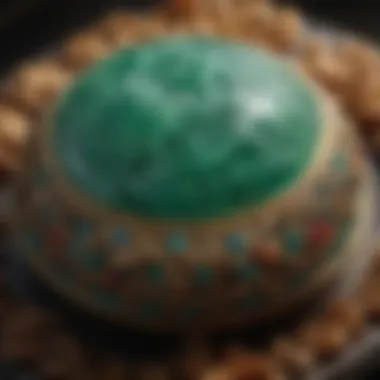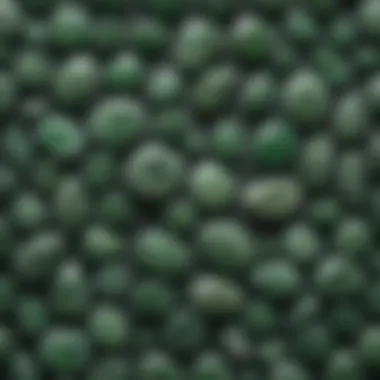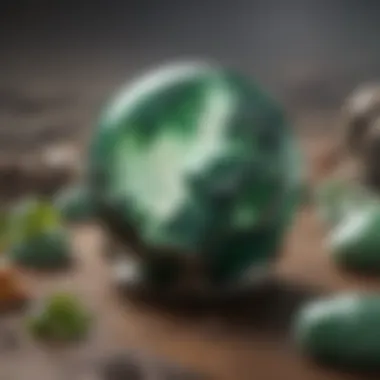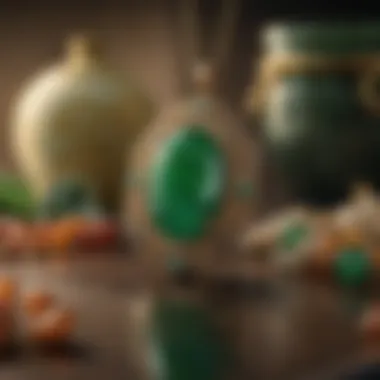Understanding Jade Pricing: Insights and Market Trends


Intro
Jade is not just a gemstone; it is a symbol of cultural heritage, beauty, and wealth. Understanding the price of jade requires exploration of its multifaceted layers. These layers include historical significance, market dynamics, and the geological characteristics that influence value. In this article, we delve into the elements that affect jade pricing and provide insights that will benefit gemstone enthusiasts, collectors, and anyone interested in this precious stone.
Overview of Gemstones and Minerals
The world of gemstones is vast and complex. Throughout history, gemstones have not only served as decorative items but have also played significant roles in various societies and cultures.
History of Gemstone and Mineral Use
Gemstones and minerals have been used by human civilizations since ancient times. From the Egyptians adorning their pharaohs with lapis lazuli to the early Chinese using jade for tools and ornaments, the history is rich. The use of gemstones often reflects the technological advancement of the era, as techniques for mining, cutting, and polishing improved.
Significance in Culture and Society
Culturally, different gemstones carry unique meanings and significance. For example, jade holds a prominent place in Chinese culture, often symbolizing purity and moral integrity. It is also associated with wealth and prosperity, making it highly sought after. Similarly, in other cultures, gemstones may be valued for their supposed healing properties or protective qualities.
Gemstone Formation and Properties
Understanding how gemstones like jade are formed adds depth to their valuation. The formation process and inherent properties define what makes a gemstone desirable.
Formation Process of Gemstones
Jade is primarily composed of two minerals: nephrite and jadeite. These minerals form under high-pressure conditions over millions of years. The geological environments where jade is found, such as Myanmar or Canada, can significantly affect its properties and pricing.
Properties that Define Gemstones
The key properties that characterize gemstones include color, hardness, and luster. Jade is particularly valued for its rich green color, although it can also appear in white, yellow, and lavender. The hardness of jade, which ranks between 6 and 7 on the Mohs scale, adds durability, making it suitable for various ornamental uses.
Classification based on Color, Hardness, and Luster
When classifying jade or any gemstone, color is often the first attribute assessed. Color intensity and hue can influence pricing significantly. Hardness affects its treatment and use, while luster relates to how light interacts with the stone's surface.
Types of Gemstones
In the realm of gemstones, classifications emerge based on rarity, appearance, and historical context.
Precious vs.
Semi-Precious Gemstones
Jade is typically categorized as a semi-precious gemstone, though it is often valued similarly to precious stones like diamonds and emeralds due to its desirability and rarity, especially in specific colors.
Common Gemstone Varieties
Within the jade category, nephrite and jadeite are common. Jadeite, being rarer and often pricier, is more sought after among collectors.
Exotic and Rare Gemstones
Beyond the common varieties, there are also rare types of gemstones that capture the attention of collectors. For example, deep Imperial jadeite is prized for its vibrant green color and can command extremely high prices.
Identifying and Evaluating Gemstones
To assess jade or any gemstone's value accurately, several factors come into play.
Factors Affecting Gemstone Value
Quality tends to hinge on clarity, color, and craftsmanship. For jade, the stone’s translucency and evenness of color are crucial.
Techniques for Gemstone Identification
Professionals often use tools like a loupe or microscope to identify and evaluate gemstones. Lab tests can also provide definitive insights into the composition and authenticity of jade.
Assessing Gemstone Quality


Factors to evaluate include:
- Color: The richness and saturation of jade’s color are paramount.
- Clarity: The presence of impurities, or lack thereof, affects value significantly.
- Cut: A well-crafted piece will enhance visual appeal and, in turn, price.
Caring for Gemstones
Proper care is essential for preserving the beauty of jade and other gemstones over time.
Cleaning and Storing Gemstones Properly
To clean jade effectively, a soft cloth dampened with water and mild soap generally suffices. Avoid harsh chemicals that may damage the stone’s surface. Ideally, store jade in a cool, dry area, away from direct sunlight to prevent any discoloration or damage.
Avoiding Common Mistakes in Gemstone Care
One common mistake is exposing gemstones to extreme temperature changes. This can cause fractures or discoloration in stones, particularly jade.
Preservation Tips for Specific Gem Types
For jade, it is advisable to occasionally apply a light mineral oil, which can enhance its luster and protect it.
The value of jade is not static. It fluctuates based on market demand, cultural significance, and individual qualities, making it both a cherished and strategically wise investment.
Understanding these aspects of jade and its market dynamics offers useful insights to those interested in collecting or investing in this notable gemstone. The journey through jade’s history, characteristics, and care opens avenues for deeper appreciation and knowledge among fans and collectors.
Prolusion to Jade
Jade has a long-standing presence in human culture, serving as more than just a beautiful gemstone. Its intricate history, coupled with its substantial cultural significance, makes this topic important for both gemstone enthusiasts and investors. Understanding jade is essential for appreciating its value in various contexts, market dynamics, and as a collectible item.
Definition and Origins of Jade
Jade refers to two distinct minerals: nephrite and jadeite. Nephrite is often found in shades of green, gray, and white, while jadeite displays a wider range of colors, including more vibrant hues. Both types have been used by various cultures for thousands of years, originating from places like Central and South America, and East Asia. Discovering the origins of jade provides insight into its historical uses and how it has carved its niche in the global market.
The earliest evidence of jade use can be traced back to ancient civilizations that utilized it for tools, ornaments, and ceremonial objects. Its durability and aesthetic appeal made it ideal for crafting items that have stood the test of time, enhancing its desirability over centuries. Understanding the geological formation of jade furthers appreciation of this gemstone's complex nature and contributes to insights about its price dynamics in the modern marketplace.
Cultural Significance Across Civilizations
Throughout history, jade's significance transcended mere decoration. In Chinese culture, jade symbolizes purity, nobility, and immortality. It is deeply integrated into traditions, from funerary practices to artistic expressions. Additionally, jade's spiritual connotations extend to signifying luck and protection, reinforcing its prominence in Chinese folklore.
Other civilizations also held jade in high regard. In Mesoamerican societies, the Olmecs, Mayans, and Aztecs incorporated jade into ceremonial artifacts, showcasing its religious and cultural importance.
Jade is not just a gem; it embodies cultural identity and serves as a bridge between the past and present.
The artistry involved in jade carving underscores its significance as not only a material object but as a form of heritage. From jewelry to religious artifacts, the cultural relevance of jade imparts depth to its price and valuation in the current market, further elucidating the need for a comprehensive understanding of this gem’s dynamics.
Types of Jade
Understanding the types of jade is essential when exploring its market value and appeal. The term
Factors Influencing the Price of Jade
The pricing of jade is a complex issue, stemming from various factors that intricately weave together the market dynamics. Understanding these components can provide gemstone enthusiasts and collectors with valuable insights into their investments. This section explores the crucial factors that affect jade's price, including material quality, market demand, and historical trends.
Material Quality and Composition
Material quality and composition play a significant role in determining the price of jade. The two primary types of jade are nephrite and jadeite, each with distinctive properties. Jadeite is considered rarer and thus commands a higher market value. Assessing the quality of jade involves examining its color, texture, and translucency.
A few aspects of material quality include:
- Color: The most prized color is often the deep green found in jadeite.
- Translucency: The more transparent the jade, the more valuable it is considered.
- Texture: A smooth and even surface enhances the overall aesthetic appeal, increasing its worth.
Collectors should be aware that synthetic jade, often made in laboratory settings, may imitate natural jade in appearance but generally lacks the same value. Buyers should always seek certification from reputable gemological laboratories to assure authenticity.
Market Demand and Availability


The demand for jade significantly influences its market price. Regions where jade holds cultural significance, like China, see an immense appetite for high-quality jade items. Conversely, if the supply is limited, increased demand can drive prices higher. It’s essential to consider both the global and local market trends.
Some factors impacting market demand are:
- Cultural Events: Festivals and celebrations in jade-rich cultures often escalate jade purchases.
- Economic Conditions: Wealth in areas known for jade can lead to increased sales.
- Fashion Trends: The popularity of jade in jewelry can fluctuate, affecting overall demand.
Emerging markets have shown increased interest in jade, broadening the consumer base and possibly further driving prices up.
Historical Trends in Pricing
Historical pricing trends offer significant insight into jade's current value. Understanding past behaviors helps predict future price movements. Potential fluctuations in jade prices can often be traced back to several pivotal points in history.
Key historical influences include:
- Trade Agreements: Changes in international trade frameworks can alter availability and affect prices.
- Cultural Shifts: Reinterpretation of jade's value can emerge from changing cultural narratives or societal priorities.
- Market Crises: Economic downturns often see a dip in jade prices, activating more cautious buying behavior.
In summary, the interplay of material quality, market demand, and historical context shapes the landscape of jade pricing. By grasping these elements, enthusiasts can make informed decisions when investing in jade, ensuring their purchases reflect both aesthetic delight and monetary value.
"Understanding the intricate factors that affect jade's price is essential in navigating the market and making astute investment choices."
Valuation Criteria for Jade
Valuation criteria for jade are essential components in determining its market value. Jade, a gemstone steeped in history and cultural significance, demands careful consideration when it comes to assessing its worth. A comprehensive understanding of these criteria not only aids collectors and investors in making informed decisions but also enhances the appreciation of this remarkable stone. As the jade market evolves, being aware of the valuation criteria becomes increasingly relevant.
Translucency and Color Intensity
Translucency is a fundamental attribute affecting the value of jade. High-quality jadeite, the more sought-after type, boasts a level of translucency that allows light to pass through without losing integrity. This feature enhances the stone's allure and is a primary determinant of its market price.
The color intensity of jade also plays a crucial role. Vivid greens, particularly those that display a uniform and rich hue, command higher prices. Other colors, such as lavender or yellow, may also hold value, but their worth is often contingent on their rarity and visual appeal. Both translucency and intensity merge to create a visual tapestry that influences customer perceptions and, consequently, the market price.
High translucency combined with intense color can significantly increase jade's value.
Collecting jade involves understanding how these qualities interact. Buyers should assess the depth of color and the clarity with which light transmits through the stone. Variations impact desirability. For instance, jade with a milky appearance, despite being intriguing, typically carries lower market value than its translucent counterparts.
Carat Weight and Size
Carat weight is another pivotal aspect influencing jade valuation. In the gemstone market, size is often equated with value. Larger pieces of jade, especially those that maintain quality in translucency and color, can fetch exponentially higher prices. For jadeite, pieces weighing over ten carats are particularly valuable.
Size and weight are complemented by the shape of the jade piece. Unique shapes can enhance the aesthetic appeal of jade, leading to higher prices. Jewelry and art pieces that utilize exquisite jade shapes often attract premium valuations due to their distinctive qualities and craftsmanship.
In concluson, the valuation of jade encompasses both translucency and color intensity, as well as carat weight and size. By understanding these criteria, both novice enthusiasts and seasoned collectors can approach the jade market with greater confidence, optimizing their investment potential while truly appreciating the beauty of this historical gemstone.
Current Market Analysis
Current market analysis of jade is crucial for understanding its pricing structure and the various influences that affect its value. By examining emerging trends and the role of online sales platforms, collectors and investors can make informed decisions. In this context, the significance of market dynamics cannot be overstated. It aids enthusiasts in grasping the factors contributing to price fluctuations, enhancing their investment strategies.
Emerging Trends in Jade Sales
The jade market has seen several emerging trends that are reshaping how jade is bought and sold. One significant trend is the increasing demand for high-quality jadeite over nephrite. Buyers are more adept at distinguishing between types of jade, often favoring unique colors and patterns.
Another noteworthy trend is the growing popularity of jade in both traditional and modern jewelry designs. Jewelers are leveraging jade to create pieces that appeal to a younger, more fashion-conscious demographic. This shift presents opportunities for investors, as the nostalgia and heritage associated with jade attract a wider audience. Additionally, environmental considerations are becoming more important. Consumers increasingly prefer ethically sourced jade, which may influence pricing as well.
In summary, these factors push collectors and investors to stay updated on market trends, as they significantly impact the value of jade.
Impact of Online Sales Platforms
The rise of online sales platforms has dramatically transformed the jade market. Websites such as Facebook Marketplace and specialized e-commerce platforms now offer a space for jade vendors to reach a broader audience. This accessibility is beneficial for buyers, as it increases competition among sellers, often resulting in better pricing and more diverse options.
Moreover, social media has created a community around jade collecting and appreciation. Forums on Reddit and other platforms enable enthusiasts to share insights, trends, and personal stories related to their jade pieces. This communal knowledge has the potential to elevate demand based on personal recommendations and social validation.
The impact of technology on jade sales is profound. Buyers no longer need to visit physical stores to access quality jade; they can do so from the comfort of their homes.
However, with this access comes the risk of misinformation. Potential buyers must be cautious about authenticity, as online sales can sometimes feature counterfeit products. Therefore, it is essential to engage with trustworthy sellers who provide guarantees for their jade's quality.


Regional Sources of Jade and Their Pricing
Understanding the pricing of jade necessitates a deep dive into its regional sources. Each geographical area contributes unique characteristics and influences the market significantly. Variations in quality, cultural relevance, and global demand impact pricing structures. Thus, knowing the source of jade is vital not only for valuation but also for potential investment.
Jade from Myanmar
Myanmar, formerly known as Burma, is renowned for its exceptional jade, specifically jadeite. The jadeite from this region is often regarded as the finest quality available, characterized by its vivid colors and strong translucency. Notably, jadeite fetches high prices, especially the imperial jade, which is an intense green and highly sought after.
The extraction processes in Myanmar have undergone many challenges, including illegal mining and geopolitical issues, which can influence availability and pricing.
- Quality Factors: The market highly values jadeite’s quality traits such as color saturation, clarity, and translucency.
- Cultural Impact: In Myanmar, jade holds immense cultural significance, which adds to its value. It is considered a symbol of status and prosperity.
Nephrite Sources in China
Nephrite jade, primarily sourced from specific regions in China, presents a contrasting profile to jadeite. Historically, nephrite was the first form of jade used by Chinese civilizations. The sources mostly include Xinjiang and Henan provinces.
Nephrite is less expensive than jadeite and is typically available in a wider range of colors, from green to white. The price difference also reflects the general availability and quality concerns about nephrite compared to the rarer jadeite.
- Market Position: Nephrite remains in demand among collectors, although its market is different due to lower pricing.
- Cultural Relevance: Just like myanmar jade, nephrite is a significant part of Chinese cultural heritage, often used in traditional carvings and ornaments.
International Markets and Their Impact
The trade of jade is no longer confined to its regional origins. International markets have opened up new avenues for pricing and valuation. Countries around the world have started to appreciate jade as both a gemstone and an investment asset.
- Market Dynamics: Countries such as the United States, Canada, and Australia have seen a rise in demand for jade jewelry and artifacts. This global interest affects prices and availability.
- Investment Considerations: Investors look at jade not merely through aesthetic appreciation but also as a hedge against economic fluctuations.
In summary, each region where jade is sourced plays a critical role in its pricing and valuation. Understanding the nuances of these sources allows both enthusiasts and investors to navigate the market more effectively.
Investor Considerations
Investing in jade can be both rewarding and complex. The value of jade is not solely determined by its aesthetic beauty. Investors need to understand multiple factors that influence pricing dynamics in the market. Key considerations include the long-term value of jade, the potential for resale, and insights into the collector's market.
Long-Term Value and Resale Potential
Jade's valuation tends to increase with time, making it a viable long-term investment. Historical data shows that certain qualities of jade have appreciated significantly. The key aspects that contribute to its long-term value include:
- Quality of Material: Nephrite and jadeite possess different values, with jadeite generally fetching higher prices.
- Rarity: Unique color variations and sizes can make certain pieces more desirable. For example, imperial jade is highly sought after.
- Market Trends: Awareness of current market demand plays a crucial role. Investors should research trends and price behavior of different jade types.
Resale potential relies largely on these factors. The right piece can yield substantial returns, especially when bought at a lower price during unfavorable market conditions. Knowing when to sell is equally important.
Collector's Market: Tips and Insights
The collector's market for jade can be intricate. Enthusiasts often seek specific characteristics, and understanding these nuances can guide investors effectively.
- Educate Yourself: Knowledge about jade types, which include nephrite and jadeite, is essential. Each type has distinct characteristics that impact value.
- Documentation: Ensure proper certification exists. Certificates authenticate the quality and type of jade, which can enhance resale value significantly.
- Networking: Engage with fellow collectors through forums or events. Websites like reddit.com may offer insights into community trends and experiences.
Investing in jade demands careful consideration of various factors. Understanding both long-term value and insights into the collector's market can effectively guide investment strategies.
Investing in jade is not merely a transaction; it is about valuing culture, history, and artistry that has persisted for centuries.
Culmination
Understanding jade's price dynamics is essential for anyone involved in its trade or collection. The intricate interplay of material quality, market demands, and cultural significance shapes jade's value. By summarizing these elements, we recognize the importance of informed decision-making for both collectors and investors.
Summarizing Jade's Price Dynamics
The price of jade fluctuates due to several key factors. Material quality plays a significant role, with jadeite generally commanding higher prices than nephrite. Other considerations include translucency, color intensity, and carat weight. The cultural significance attached to jade also inflates its desirability, especially in regions where it holds historical importance. Current market trends reveal a growing demand for high-quality jade due to its perceived investment potential. In recent years, this has led to some noteworthy price increases, particularly for rare specimens.
Here are some critical aspects of jade pricing:
- Quality of Material: Variations in composition and quality can lead to substantial price differences.
- Market Demand: Changes in consumer preferences and economic conditions directly affect pricing.
- Cultural Relevance: The historical importance of jade often elevates its value in certain markets.
By comprehensively examining these factors, stakeholders can better navigate the complexities of jade pricing.
Future Perspectives on Jade Valuation
Looking ahead, jade valuation is expected to evolve significantly. An increasing appreciation for sustainable and ethically sourced gems may steer consumer choices and influence pricing structures. Additionally, as more collectors and investors enter the market, we could witness a rise in demand for unique, high-quality jade pieces. Efforts to promote jade's cultural heritage in various regions may further enhance its global perception.
Key trends that may shape jade valuation include:
- Ethical Sourcing: Growing awareness around sustainable practices may become pivotal in future valuation.
- Global Market Expansion: Emerging markets might foster increased interest and competition within the jade sector.
- Technological Advancements: Innovations in online retail strategies may alter how jade is marketed and sold.







